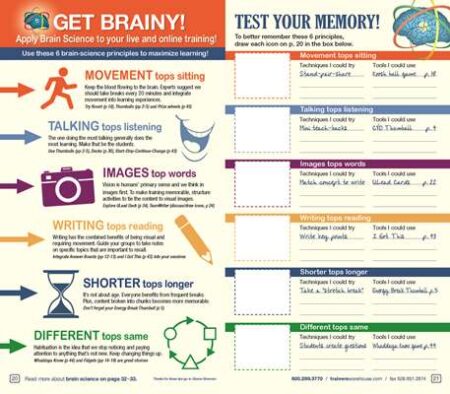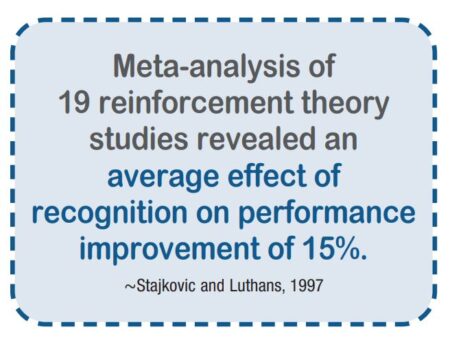Brain Science in Training
 We’re often asked if these creative, brain-based learning techniques work. We think using brain science in training works, but try it yourself. Complete this brain science worksheet, then see how many of the 6 brain-science principles you remember. Brain research focusing on learning and memory continues to deepen. The research is so voluminous now that we’ve synthesized the key findings and assembled dozens of ideas to help make your training more innovative, effective, and fun.
We’re often asked if these creative, brain-based learning techniques work. We think using brain science in training works, but try it yourself. Complete this brain science worksheet, then see how many of the 6 brain-science principles you remember. Brain research focusing on learning and memory continues to deepen. The research is so voluminous now that we’ve synthesized the key findings and assembled dozens of ideas to help make your training more innovative, effective, and fun.
GREATER ENGAGEMENT = DEEPER LEARNING
The more areas of the brain you involve in learning, the more memorable it becomes. To engage more senses, think of TAMMIE…
- Touch – activate learners’ tactile sense with fidget toys and writing.
- Aromas – scents and smells can keep participants engaged and alert. Plus, they’ll trigger memories down the road.
- Movement – incorporate physical movement of any kind. Walking at least 10 paces sends 15% more oxygen to the brain after 1 minute.
- Music – not only is music engaging and memorable, but it can act as a memory trigger.
- Images – utilize all sorts of visual images from photos, icons, and pictures, to illustrations and drawings.
- Emotions – stories, competitive games, and strong feelings will help participants stay focused and remember what they experienced.
 BETTER FOCUS = MORE KNOWLEDGE
BETTER FOCUS = MORE KNOWLEDGE
Anyone who has sat through a presentation recently knows it’s hard to stay focused for more than 10-20 mins. To improve focus, try these tips:
- Keep it short. Break 40-minute segments into two 20-minute sessions.
- Change-it-up. Alter teaching methods frequently. Add an activity, game, group challenge, or pair-and-share. Go off-topic for quick asides.
- Doodle. Besides the fact that doodling requires movement, it can also enhance memory.
- Take a hike. To increase blood flow, have learners stand up to discuss questions. Or, ask them to write an answer on their own, then stand and walk at least 10 paces to find a discussion partner.
- Shush! Avoid lectures. Let class participants do the talking and teaching.
- Pause. Give learners time to consider new information and store it along with something they already know.
- Practice. Increase the amount of time and ways in which students engage with the material.
MEMORY HACKS = LONGER RETENTION
Unless we work really hard at remembering something through focus, practice, and repetition, we’re likely to forget as quickly as one-day or even-one hour after learning it. Heck, haven’t we all forgotten people’s names within moments of learning them? Brain science in training memory hacks work because they make us focus on new information, process it, then consciously store it in our brains. To supercharge your group’s memory, have them try on these creative personas:
- Pen Pal: Writing is a kinesthetic activity that helps us remember. Ask learners to “write this down,” use worksheets, or highlight key learning points.
- Drama Queen: Have participants create and share a story that dramatizes a key learning point.
- Whiz Kid: Create a mnemonic where each letter stands for a key concept, like TAMMIE on page 32 or “every good boy does fine” (to remember musical notes E, G, B, D, F).
- Songwriter: Challenge groups to make up a jingle to jog their memory.
- Artist: Draw an icon or choose a striking visual image that represents a key point.
GOOD HORMONES = BETTER BRAIN ACTIVITY
My 9th-grade biology teacher said “if you don’t know an answer, guess “hormones.” Hormones is the right answer here too. Simply, endorphins are the hormones that promote feelings of euphoria and stimulate our frontal lobes (the part of our brain responsible for learning). Cortisol is the hormone that inhibits memory and attention. It is released into our bloodstream when we’re under stress. To Enhance Endorphins:
- Inspire laughter with jokes or silliness. Laughter reduces at least four o neuroendocrine hormones including cortisol.
- Create Warm Welcomes: Make learners feel welcome. Say hello to participants by name.
- Praise effort, not success: Make everyone feel capable and respected.
- Say their names: Address participants personally. Refer to previous contributors to show you value their input. To Crush Cortisol:
- Work in teams. Minimize stress by having participants work together. Don’t put individuals on the spot.
- Celebrate mistakes. If people think mistakes will yield judgment or criticism, they’ll withdraw and resist making mistakes.
With two dozen tips to apply brain science in training, we challenge you to try just a few.



